|

“Almost like a real web
site”
|
IN7OMM.COM
• Search |
Contact
• News |
e-News |
• Rumour Mill |
Stories
• Foreign Language
• in70mm.com auf Deutsch
WHAT'S ON IN 7OMM?
7OMM FESTIVAL
• Todd-AO Festival
• KRRR! 7OMM Seminar
• GIFF 70, Gentofte
• Oslo 7OMM Festival
• Widescreen Weekend
TODD-AO
• Premiere |
Films
• People |
Equipment
• Library |
Cinemas
• Todd-AO Projector
• Distortion Correcting
PANAVISION
• Ultra Panavision
70
• Super Panavision
70
|
 |
|
VISION, SCOPE & RAMA
1926
Natural Vision
1929 Grandeur
1930 Magnifilm
1930 Realife
1930 Vitascope
1952 Cinerama
1953
CinemaScope
1955 Todd-AO
1955 Circle Vision
360
1956
CinemaScope 55
1957 Ultra
Panavision 70
1958 Cinemiracle
1958 Kinopanorama
1959 Super
Panavision 70
1959 Super Technirama 70
1960 Smell-O-Vision
1961 Sovscope
70
1962
Cinerama 360
1962 MCS-70
1963 70mm Blow Up
1963 Circarama
1963 Circlorama
1966 Dimension 150
1966
Stereo-70
1967 DEFA 70
1967 Pik-A-Movie
1970 IMAX / Omnimax
1974 Cinema
180
1974 SENSURROUND
1976 Dolby Stereo
1984 Showscan
1984 Swissorama
1986 iWERKS
1989 ARRI 765
1990 CDS
1994 DTS / Datasat
2001
Super Dimension 70
2018 Magellan 65
•
Various Large format
| 70mm to 3-strip |
3-strip to 70mm |
Specialty Large Format |
Special Effects in 65mm |
ARC-120 |
Super Dimension 70
| Early Large Format
• 7OMM Premiere in
Chronological Order
7OMM FILM & CINEMA
• Australia |
Brazil
• Canada |
Denmark
• England |
France
• Germany |
Iran
• Mexico |
Norway
• Sweden |
Turkey
• USA
LIBRARY
• 7OMM Projectors
• People |
Eulogy
• 65mm/70mm Workshop
• The 7OMM Newsletter
• Back issue |
PDF
• Academy of the WSW
7OMM NEWS
• 2026 | 2025 | 2024
• 2023 |
2022 |
2021
• 2020 |
2019 |
2018
• 2017 |
2016 |
2015
• 2014 |
2013 |
2012
• 2011 |
2010 | 2009
• 2008 | 2007 |
2006
• 2005 | 2004 |
2003
• 2002 |
2001 |
2000
• 1999 |
1998 |
1997
• 1996 |
1995 |
1994
|
|
in70mm.com Mission:
• To record the history of the large format movies and the 70mm cinemas
as remembered by the people who worked with the films. Both during
making and during running the films in projection rooms and as the
audience, looking at the curved screen.
•
in70mm.com, a unique internet based magazine, with articles about 70mm
cinemas, 70mm people, 70mm films, 70mm sound, 70mm film credits, 70mm
history and 70mm technology. Readers and fans of 70mm are always welcome
to contribute.
•
Disclaimer |
Updates
• Support us
• Testimonials
• Table of Content
|
| |
| |
Extracts and longer
parts of in70mm.com may be reprinted with the written permission from
the editor.
Copyright © 1800 - 2070. All rights reserved.
Visit biografmuseet.dk about Danish cinemas

|
| |
Large Format in Brazil, part I: 70mm in Rio |
Read more at
in70mm.com
The 70mm Newsletter
|
| Written by: Paulo Roberto P. Elias, Rio de Janeiro, Brazil |
Date:
22.09.2009 |
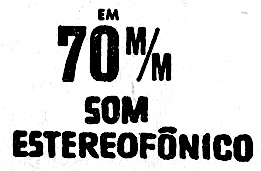 Rio de Janeiro was the capital of Brazil until the early 1960’s, when the government moved to Brasília. Understandably, the town itself was the place for the cultural convergence of many sorts of foreign influences, including French architecture and North-American and European movie going cultural habits, throughout decades. The American studios themselves had a strong presence in the early 1900’s, but one of the first exhibitors imported the Lumières’ “cinématographes” during the beginning of the theatrical era at the city centre. Rio de Janeiro was the capital of Brazil until the early 1960’s, when the government moved to Brasília. Understandably, the town itself was the place for the cultural convergence of many sorts of foreign influences, including French architecture and North-American and European movie going cultural habits, throughout decades. The American studios themselves had a strong presence in the early 1900’s, but one of the first exhibitors imported the Lumières’ “cinématographes” during the beginning of the theatrical era at the city centre.
That is also to say that in its most prolific period of theatrical installations, namely during the mid-1030’s and early 1940’s, the ubiquitous presence of art-déco architecture could be noticed. These were many times majestic and quite large exhibition halls, something that would prove fruitful when 70mm projections finally came to town.
• Go to Palácios e Poeiras
• Go to Large Format in Brazil, part II: The
Incol 70/35 projector
• Go to 70mm Rundown in Rio Revised
• Go to 70mm Films shown in
Brazil
• Go to Mr. Orion Jardim de Faria - A
visit to a Brazilian 70mm film Pioneer
• Go to The Incol
70-35 projector
• Go to The Passing of Orion
Jardim de Faria
• Go to Falecimento de Orion
Jardim de Faria
|
More in 70mm reading:
Palácios e Poeiras
Large Format in Brazil, part II: The Incol
70/35 projector
70mm Rundown in Rio Revised
70mm Films shown in
Brazil
Mr. Orion Jardim de Faria - A
visit to a Brazilian 70mm film Pioneer
The Incol
70-35 projector
The Passing of Orion
Jardim de Faria
Falecimento de Orion Jardim de
Faria
|
In the beginning… |
|
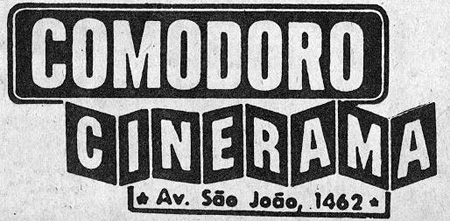 In the early to the mid 1950’s Hollywood had turned its attention to overtake the influence of television on the American public declining presence in theaters. First, there was Cinerama, and later on 70mm, which, by the way, had been tried in the 1930’s with the name Grandeur (Fox Films) but did not succeed. For reasons that I am not aware of, neither of these formats reached Rio’s shore during that period. In the early to the mid 1950’s Hollywood had turned its attention to overtake the influence of television on the American public declining presence in theaters. First, there was Cinerama, and later on 70mm, which, by the way, had been tried in the 1930’s with the name Grandeur (Fox Films) but did not succeed. For reasons that I am not aware of, neither of these formats reached Rio’s shore during that period.
In fact, it was by the initiative of an entrepreneurial individual from São Paulo that the original 3-strip Cinerama installation was finally realized. The story is very well illustrated and told in this interesting photo blog. Briefly, the Cinema Comodoro, located in the very city centre of the city of São Paulo, opened its doors on August 14th 1959, to show “This is Cinerama”, much to the excitement of the local people and town’s visitors. The theater would, in later years, be converted to 70mm but keeping the same Cinerama curved screen. That was possible because American studios were providing rectified 70mm prints, which would fit, with minor adjustments, the highly curved screen previously used for the 3-strip format process.
|
August 2009
Dear Mr. Thomas
Here in Brazil things are very complicated. I think there's nothing left of 70mm! ... unfortunately! We have the IMAX! Only this system in the wide format! One or two rooms.
I hope that the Glamor of the films in 70mm born again here! Successes for the project.
I was happy to learn that Mr. Paulo Roberto is proposed to write the article for the site! I'm sure that had been sensational.
I thought it better to write, because his English is much better! I'll be passing some information to help in the text and the most I can. I hope that everything goes and be a success! I am available for whatever you need.
See you soon,
Eder Delatore
Cinema Paratodos |
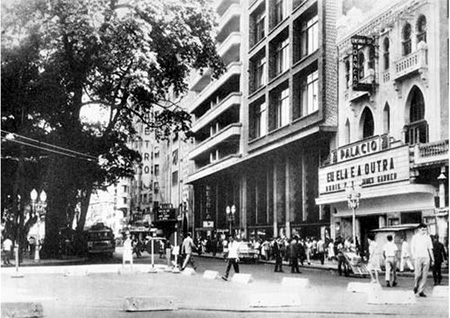 Cinema Palácio: the very first with CinemaScope and stereo sound. Please note: at the bottom of this photograph one can also see the Metro-Passeio, which gave place to the Metro-Boavista, the only Dimension 150 theater in Brazil.
Image from a photoblog. Cinema Palácio: the very first with CinemaScope and stereo sound. Please note: at the bottom of this photograph one can also see the Metro-Passeio, which gave place to the Metro-Boavista, the only Dimension 150 theater in Brazil.
Image from a photoblog.
Curiously, neither the first 70mm attempt tried by the Grandeur format nor the 3-strip Cinerama process ever managed to be installed in Rio. Cinerama 3-strip was restricted to the Comodoro, in São Paulo.
|
|
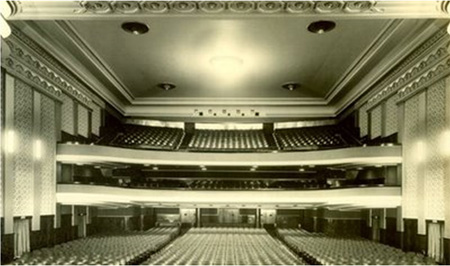 Inside the Palácio, fitted later with “flat” 70mm screen and projection system. Image from kinoplex.com.br Inside the Palácio, fitted later with “flat” 70mm screen and projection system. Image from kinoplex.com.br
However, in the mid-1950’s one of its main exhibitors, Mr. Luiz Severiano Ribeiro, converted the beautiful Cinema Palácio to 35mm CinemaScope, 4-track stereo, as soon as “The Robe” was released by Fox. The Palácio became then the first theater to install and fully exhibit the CinemaScope format in the country. CinemaScope was not as photographically and sound-wise powerful as Cinerama, but people who attended this first screening were marvelled by its presentation.
Soon, other palace theaters, mainly at the city centre, were all fitted for full CinemaScope presentations, and this was basically the reason why all of the former pictures photographed in 70mm formats, namely Camera 65, Todd-AO, Super Technirama 70 and Super Panavision 70, were presented in 35mm CinemaScope prints with 4-track magnetic stripes stereo sound, until the mid-1960’s. Several years after the establishment of 70mm projections, most of those earlier 70mm pictures would finally be seen as originally intended, including an awkward transcript to 70mm of a former 3-strip Cinerama project!
|
|
70mm finally comes to town… |
|
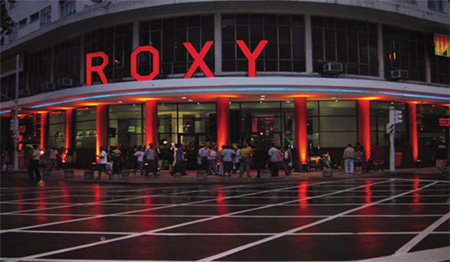 The main entrance of the Roxy theater these days. The theater is still open, but divided by three! Image from kinoplex.com.br The main entrance of the Roxy theater these days. The theater is still open, but divided by three! Image from kinoplex.com.br
It was 1965. With great fanfare, the Cinema Vitória, which was previously the elected theater première for the 35mm CinemaScope version of “Around the world in 80 days”, opened its first 70mm screening, with the Super Panavision print of “My Fair Lady”. The Vitória was large enough for fitting a very wide and tall 70mm screen. Its stereophonic playback system was nothing short of state-of-the-art. As a result, as soon as the opening bars of the flowered overture of "My Fair Lady" started, with the curtains opening to full screen, the theater was flooded with spectacular imagery and sound, much to the amazement and enthusiasm of the patrons.
The Vitória theater was, for a short while, the only hall in town fitted with 70mm projection. After successfully showing "My Fair Lady", they went on to other spectacular 70mm presentations, such as that of Carol Reed’s “Oliver!”
At that point, most movie fans, I suppose, would not notice the difference between pictures that were actually photographed with 70mm cameras and movies made with 35mm photography and subsequently blown-up to 70mm. In addition, that sort of information was never explicitly publicized to the general viewing public. Actually, many movie trailers would contain the information “in 70mm and stereophonic sound” displayed as an attraction to movie goers.
|
|
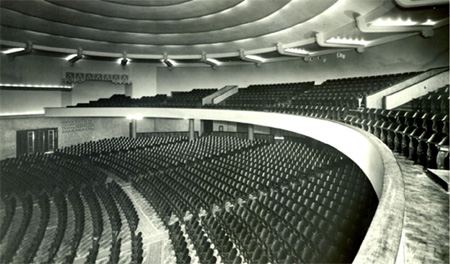 Older picture of the Roxy exhibition hall, which was modified later to the Cinerama, ultra large, and curved screen. The theater was originally built in 1938. Image from kinoplex.com.br Older picture of the Roxy exhibition hall, which was modified later to the Cinerama, ultra large, and curved screen. The theater was originally built in 1938. Image from kinoplex.com.br
So, when the Vitória exhibited David Lean’s “Dr. Zhivago” in 70mm, a picture that falls in the afore mentioned second category, the results were so impressive, that even if they mentioned that the original photographic process was 35mm, nobody would care.
The truth is that 70mm exhibition of blown-up 35mm pictures is fully capable to pinpoint virtues of the original camera work and lenses, in addition to the magnificence of the 70mm’s format of stereophonic sound. 70mm film has brighter light coming off the projector’s lamp house, and the print itself holds 6 stripes for a highly dynamic, high-fidelity, stereo sound. The 5-channel distribution of sound speakers behind the screen, plus an additional mono surround sound, has more fidelity and less distortion than its CinemaScope counterparts.
David Lean’s “Zhivago” overture opens with the crash of cymbals on the outer edges of the screen, and with the curtains still closed. It is impossible to pass unnoticed in a big theater! The whole orchestral sound score of the overture serves as the prologue of the drama soon to be depicted on the screen. Needless to say, "Dr. Zhivago"’s 70mm presentation made quite an impact on film fans and on the general audience in those days.
But the greater impact was still to come: in 1966, the same exhibitor transformed the even larger auditorium of the Roxy theater, in the district of Copacabana, with the Cinerama 70mm screen, ostensibly displaying the Cinerama logo, slightly above the theater façade.
|
|
 Main hall of the Roxy theater, with access to the balcony.
Image from a photoblog. Main hall of the Roxy theater, with access to the balcony.
Image from a photoblog.
The Cinerama projection system of the Roxy was in actuality not that much different than the one installed at the Comodoro, in São Paulo, after the 3-trip Cinerama method came to an end, more or less at that time.
The Roxy used a deep curvature in that screen, which was impossible, according to the technicians, to be used to project 35mm prints. If this was true or not, the fact was that inside the Roxy even the supplemental material, such as trailers or any short documentary, were all projected using the 70mm format.
Theatrical 70mm at the Roxy was inaugurated with the presentation of “Battle of the Bulge”, filmed in Ultra-Panavision Cinerama. The trade mark “Cinerama®” was used in film projects of the 1960’s and could be seen in the credits of many movies:
During many years, the Roxy system was the reference system in town. Most pictures shown would cover processes like Ultra-Panavision (“The Hallellujah Trail”) or Super Panavision, or even Todd-AO.
In July 1968, the Roxy would finally meet its greatest moment: the Stanley Kubrick’s rendition of the Arthur C. Clarke novel “2001, A Space Odyssey” was exhibited with great success. Once again, the major impact for the audience relied on the imagery and the overture from the Richard Strauss’ piece “Also Sprach Zaratustra” echoing through the theater hall in the beginning of the picture. Interestingly, the same soundtrack, heard today by modern home theater gear, does not fully disclose the same dynamics that could be heard in the theater. I believe that a great deal of this lack of perception results from the unique combination of sight and sound in the theater, which can not be mimicked in home installations.
I still think that “2001” was emblematic for many movie buffs and charismatic for the science fiction fan. But, regardless of all that, the presentation itself became synonymous with the grandeur that 35mm shows never managed to achieve, even by today’s standards.
|
|
The widespread of 70mm |
|
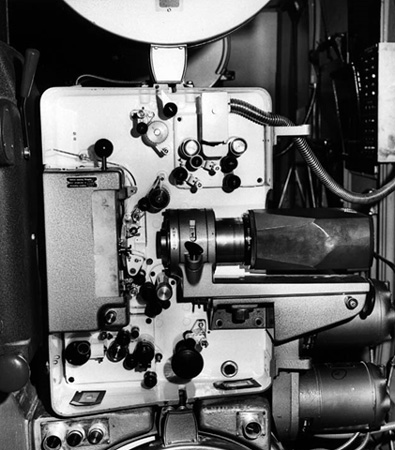 An example of 70mm projector fitted with Dimension 150 lens. Image by D-150 Inc. An example of 70mm projector fitted with Dimension 150 lens. Image by D-150 Inc.
The so-called “70mm craze” would soon widespread to the other theaters in Rio, the majority of those outside the city centre. Up to the late 1970’s, approximately 13 other theaters were fitted for 70mm using various screen types and curvatures.
During that period, the most noteworthy installation was done in the city centre. The old Metro-Passeio had been demolished in the mid-1960’s, but by 1969 in its place a new Metro-Boavista was built from scratch. The owners installed two Cinemecannica Victoria X projectors, in a system called “Dimension 150”. I must confess that at that period, I was not aware that D-150 referred to a filming format, rather than a projection system. That was perhaps because, before each film, a credit logo would inform patrons that is was “A Projection in Dimension 150”. And indeed, the 70mm projectors were fitted with special lenses to that effect:
One of the benefits of the Dimension 150 installation is that the screen is quite curved, but, unlike the one used in the Roxy for Super Cinerama, not to the point where it can prevent exhibition of 35mm material, in which case the Metro-Boavista kept its former Simplex X-L projector for all supplemental 35mm content.
|
|
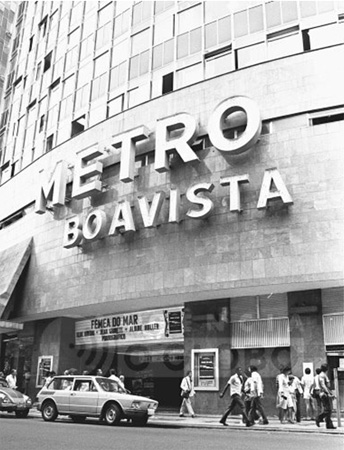 Entrance of the Metro-Boavista, circa 1970's". Image by O Globo Entrance of the Metro-Boavista, circa 1970's". Image by O Globo
Dimension 150, as a film process per se, only saw the light of the day with two film projects: “The Bible” and “Patton”. The latter was never exhibited at the Metro-Boavista, but next door, at the Palácio, which used a conventional “flat” 70mm screen.
However, rectified prints of many “flat” 70mm films were exhibited at the Metro-Boavista, using the Dimension 150 projection process. The theater would even show a new presentation of “Dr. Zhivago” using this highly curved D-150 screen!
The acceptance and success of 70mm as projection medium would allow the format to expand to other theaters in town. It was not going to happen without a strange incident though: at the end of the 1960’s, the Cinema Madrid, located in the district of Tijuca, was fitted with new 70mm projectors, and in face of its larger auditorium, the intention was the supersede the Cinerama 70mm installation of the Roxy. The first film to be projected was to be “Spartacus”. The trailer was exhibited but sadly the theater caught fire in the early 1970’s, never to reopen. Soon it would be demolished, for reasons that until today nobody is fully aware of, in other words, an unpredictable and mysterious turn of events. According to testimonies at the time and the press, only the curtain and a small amount of seats caught fire, nothing that would prevent the Madrid to reopen. But the owner put it down and sold the space to a third party. That was the end of the Madrid, but luckily not the end of 70mm installations. In that same area four theatres had 70mm systems installed, including one brand new hall, which opened with the 70mm presentation of the British musical “Half a Sixpence”.
|
|
Exploitation of the 70mm format |
|
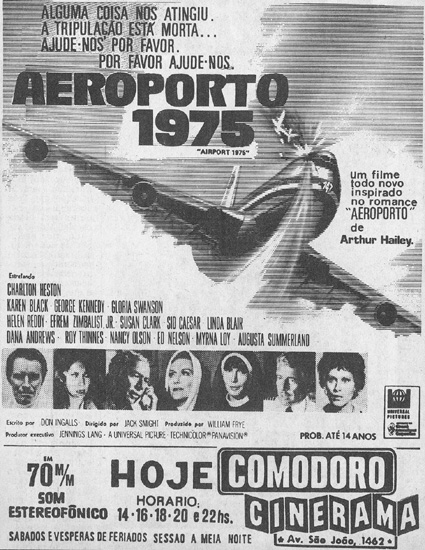 Newspaper 70mm advert from Salas de cinema de São Paolo Newspaper 70mm advert from Salas de cinema de São Paolo
An amazing amount of theatrical presentations of older films took place during the mid-1960’s, up to the early 1980’s. Studios and exhibitors were apparently making an effort to use the format as a cash cow, for this is the only explanation why so many 35mm films were used for 70mm presentations.
In one extreme example of this phenomenon it was possible to see “Gone With The Wind”, which is an academy ratio picture, in 70mm and (fake) stereophonic sound. But in some, albeit not so extreme cases, still the main intent of the filmmakers resulted in disastrous presentations. Such was the case for “The Ten Commands” (originally photographed in VistaVision), and, to a lesser disastrous degree, “Seven Brides For Seven Brothers” (originally photographed in CinemaScope and flat 35mm) in a Todd-AO installation. Some preservationists claim that the blow-up of the “Seven Brothers” 35mm picture brought the negative to the brink of extinction…
|
|
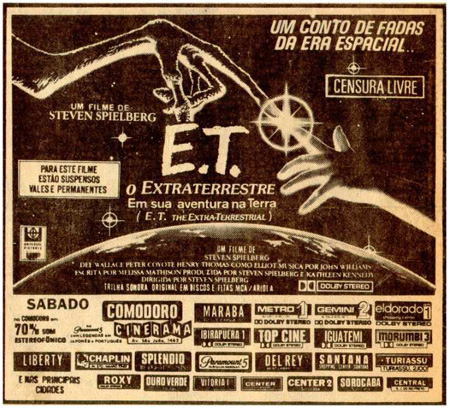 Note the Cinerama logo, still displayed for the Comodoro screening. Newspaper 70mm advert from Salas de cinema de São Paolo Note the Cinerama logo, still displayed for the Comodoro screening. Newspaper 70mm advert from Salas de cinema de São Paolo
In other cases, the 70mm exploitation had a very positive impact on the film industry, exhibitors and the public. A remarkable example can be found in the presentation of “Um Certo Capitão Rodrigo”, made by the Brazilian, Cannes winner, actor/writer/director Anselmo Duarte, in 1971.
35mm film blow-up to 70mm became commonplace in those days. A comprehensive list can be seen at the Internet Movie Database site. One of the last of such presentations I witnessed was Steven Spielberg’s “E.T.: The Extra-Terrestrial”, circa 1983. Here is a rare facsimile of the advert from the Comodoro in São Paulo, which faced the same situation:
|
|
Who took the curtains out? |
|
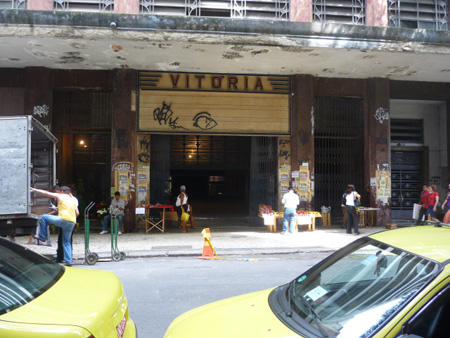 The first ever cinema fitted with 70mm, now in ruins. The hall cannot be touched though, by the mayor’s decree. Image by Paulo Roberto P. Elias. The first ever cinema fitted with 70mm, now in ruins. The hall cannot be touched though, by the mayor’s decree. Image by Paulo Roberto P. Elias.
The 1980’s finally brought a halt to 70mm film exhibition and in many cases the demise of a depressing and very long list of theaters. At first, exhibitors took the initiative to divide bigger theatres in two or three halls. At that point, most, if not all, 70mm projectors were permanently removed from the premises.
In a sad state of affairs, the main exhibitors started to close down their theaters permanently or rent them to churches or other businesses. One of the last ones to resist that fury was the Metro-Boavista. But when it stopped, everybody was certain that it would never come alive again.
|
|
 A member of the homeless movement, staring at the Vitória front stage. Please note: after the 70mm screen was removed one can see the original screen space of the theater. Picture taken on October 1st 1997 by the press and it is unrevealing of the true auditorium space. Image by O Globo Press A member of the homeless movement, staring at the Vitória front stage. Please note: after the 70mm screen was removed one can see the original screen space of the theater. Picture taken on October 1st 1997 by the press and it is unrevealing of the true auditorium space. Image by O Globo Press
Nowadays, that devastation has already completed a cycle that proved to be one of the most nefarious and malefic, done to film buffs and to the general public, turning the exhibitors attention to plain multiplex installations, needless to say, without any chance to project anything other than today’s 35mm films.
|
|
 Façade of the Metro-Boavista. The hall is apparently intact, but no information is currently supplied to what exactly it will be used for. Image by Paulo Roberto P. Elias. Façade of the Metro-Boavista. The hall is apparently intact, but no information is currently supplied to what exactly it will be used for. Image by Paulo Roberto P. Elias.
The way I see this, if I may, is that the exhibitors themselves were continuously and systematic jeopardizing film exhibition as a whole. The removal of the curtains, the complete absence of theatrical showmanship, overture and intermission music with the theaters’ lights dimming, and the poor maintenance of installations, made the public flee away from theatres, I suppose. In addition, the ongoing urban violence never had any counter offensive on behalf of theater owners or public authorities, something that surely kept people from carrying on with the habit of cinema going.
Going now to the city centre, a place that was once amorously known as “Cinelândia” (“city of cinemas”), one can witness the status of these glorious palaces:
The building of the Vitória was once invaded by homeless people of the ongoing political movement in the country:
|
|
Very few is left of the theaters’ memory! |
|
 What is even more embarrassing than the destruction of the theaters is that very few documents, specifications, and pictures of the former installations can now be found for research purposes. For that reason, most of the following information comes from my own memory: What is even more embarrassing than the destruction of the theaters is that very few documents, specifications, and pictures of the former installations can now be found for research purposes. For that reason, most of the following information comes from my own memory:
|
|
70mm theaters in Rio (some names may be missing) |
|
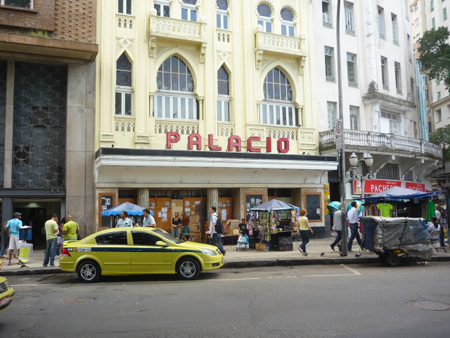 11 - Please note: there is one of my pictures missing, and this is the one showing the Palácio closed down as it is today. The former idea was to show two pictures: one with Palácio divided by two (picture 11), and the other, taken by me, as it is today. This is the one that is missing. 11 - Please note: there is one of my pictures missing, and this is the one showing the Palácio closed down as it is today. The former idea was to show two pictures: one with Palácio divided by two (picture 11), and the other, taken by me, as it is today. This is the one that is missing.
The Palácio: first with CinemaScope, then 70mm, then divided by two (first picture), then permanently closed down. It cannot be demolished or altered, due to a mayor’s decree. Image by Paulo Roberto P. Elias.
City Centre (a.k.a. “Cinelândia”) – Vitória, Palácio, Metro-Boavista, and Pathé;
North Districts (Tijuca) – Madrid, Tijuca, Rio, Bruni-Tijuca, and Tijuca-Palace;
South Districts (Flamengo, Botafogo, Copacabana, Ipanema, and Leblon) – Bruni-Flamengo, Ópera, Condor Largo do Machado, Roxy, Leblon, Super Bruni 70, and Pax.
|
|
70mm projects in use |
|
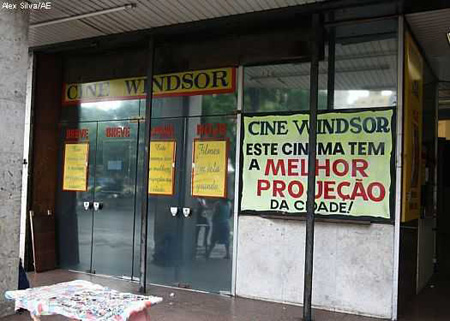 What was left of the Cine Windsor, which is mentioned in the site as a DP70 cinema. What was left of the Cine Windsor, which is mentioned in the site as a DP70 cinema.
I could find no database for theater-specific usage of 70mm projectors, but I was informed that these makes were probably used for most installations: Cinemecannica V-X, Incol 35/70, Zeiss Ikon 35/70, and possibly the Philips DP70 in the Pax theater (unconfirmed). As of this writing, the main exhibitor in Rio was not able to provide any information regarding their projectors.
|
|
About the author |
|
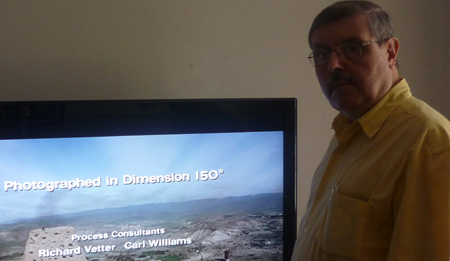 Paulo
Roberto P. Elias, Rio de Janeiro, Brazil Paulo
Roberto P. Elias, Rio de Janeiro, Brazil
Paulo Roberto Elias is a retired Adjunct Professor from the Universidade Federal do Rio de Janeiro, M.Sc. (IQ-UFRJ) and Ph.D. (Cardiff University, UK) in biochemistry. He is also a film lover and home theater hobbyist. The author has a column about Audio and Video, at the Webinsider
site.
|
|
| |
|
Go: back - top - back issues - news index
Updated
21-01-24 |
|
|
|